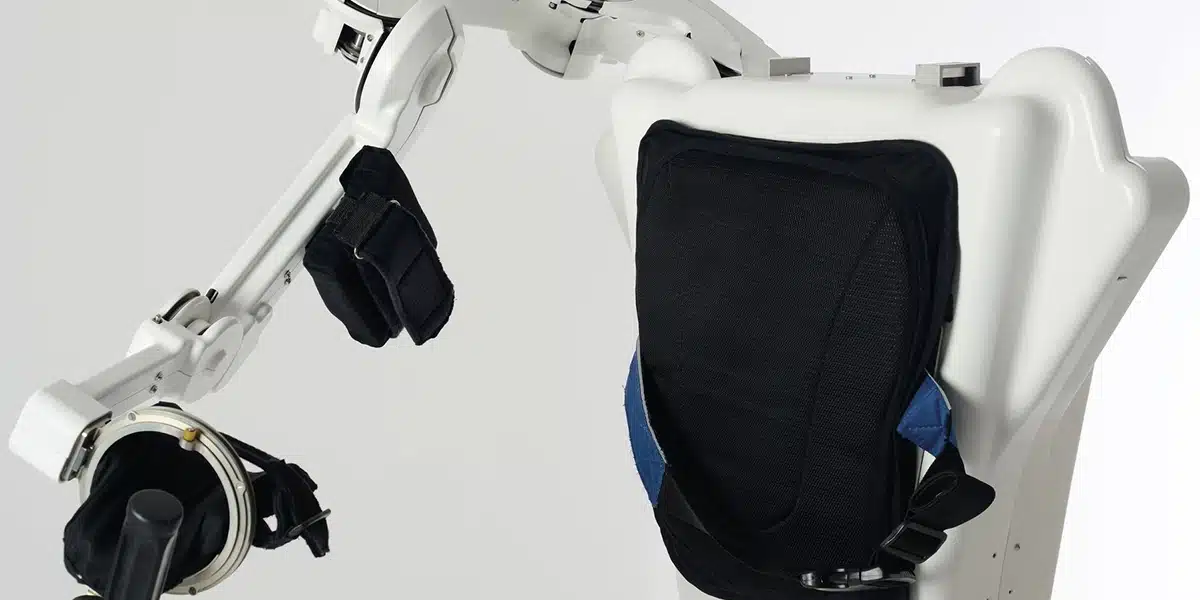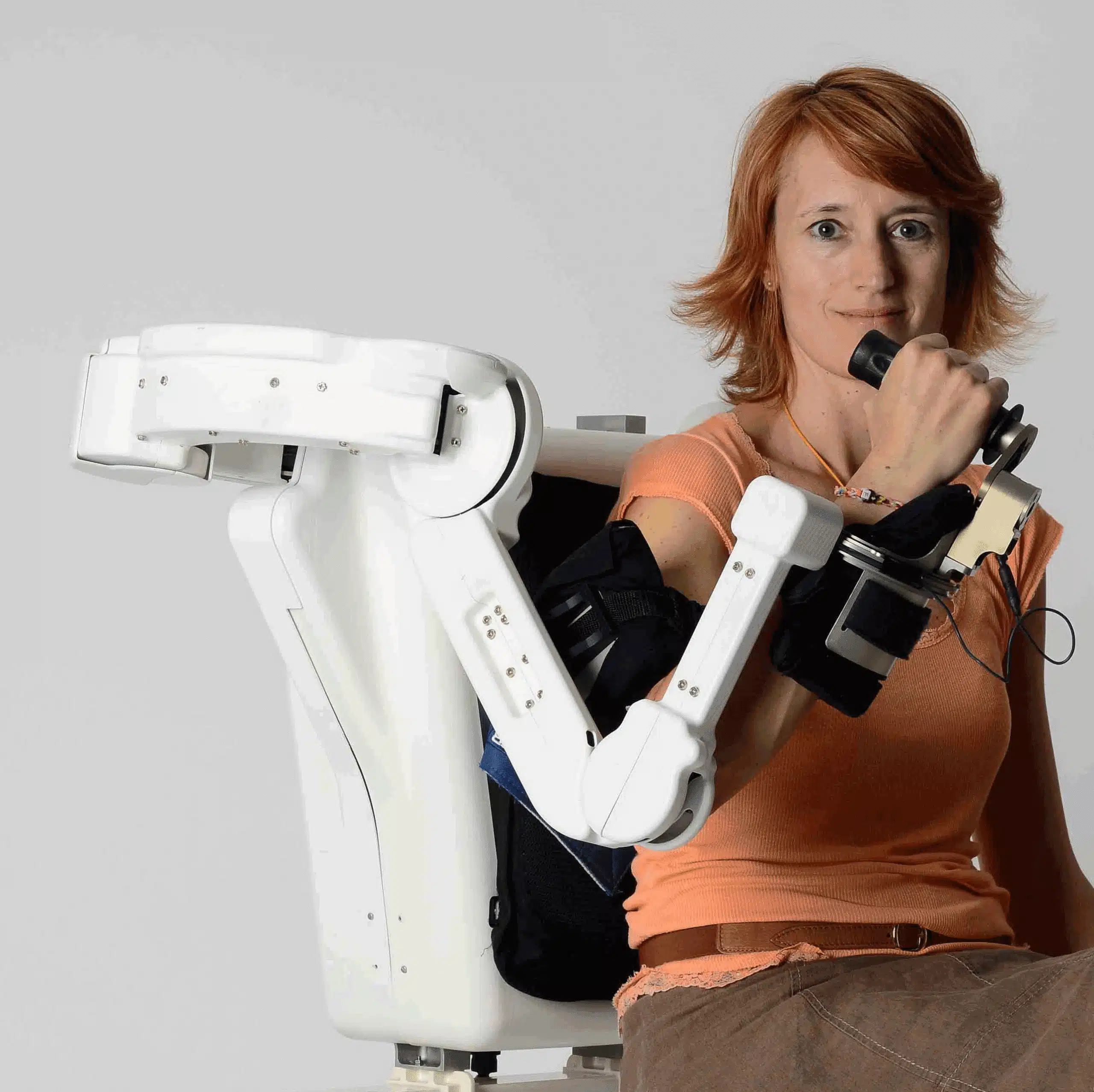“We have developed a machine that we now sell throughout Europe and which is used for the rehabilitation of the upper limbs of patients who had a stroke.”
In this context – which inevitably recalls Philip K. Dick’s novels or Japanese cartoons from the 1970s – we find Wearable Robotics, a new addition to LIFTT’s portfolio.
Wearable Robotics MD Lucia Lencioni and its Head of Marketing and Sales Fabio Piazza told us about the focus, business goals and ambitions of their Start-Up.
How did you come up with this intuition, what does it consist of and what are its applications?
‘Wereable‘, comments Lencioni, ‘originates from the perceptive robotics research laboratory of the Scuola Superiore Sant’Anna. Exoskeletons have therefore always been an area of research in our lab for 30 years. In 2014, we decided to systematise all activities and set up this company. Then, we acquired the patent that allows us to create exoskeletons from the school, i.e. robots/machines that you can ‘wear’ and that allow people to make movements or increase their performance. So, as a matter of fact, we build, design and manufacture exoskeletons. The first field in which we operate is the biomedical one. We have developed a machine that we now sell throughout Europe and which is used for the rehabilitation of the upper limbs of patients who have suffered a stroke. Based on this, we have also developed some prototypes, which we will soon industrialise, They are meant for the rehabilitation of the upper limb at different stages of the disease. We are therefore starting from the acute phase of the disease, which we treat with a machine that is already on the market, with the aim of commercialising a much simpler one that will instead be used in the chronic phase of the disease, designed for home use’.
“Another sector,’ continues the MD, ‘on which we chose to work is the industrial field. Here, the person who would wear the exoskeleton is no longer a patient but an operator, a production worker; in this case, we are talking about able-bodied staff. Here the machine is used to carry loads in place of the operator, in order to relieve the operator of the drudgery of moving loads continuously. In this area, we produce exoskeletons at a prototype level for both the upper and lower limbs, with different types of load and different payloads, that go from 5 to 40 kg. The machine can relieve the operator from 5kg up to 40kg at the maximum weight bearable.”
“This is a research order,” spoke Fabio Piazza, “that was given to us by a large Chinese company and allowed us to get to define an advanced state of prototyping of industrial exoskeletons.”
So, what is an exoskeleton and how exactly does it work?
“The exoskeleton,” explains the MD, “is, in a nutshell, a machine, a robot, a skeleton that is worn by the person and which amplifies or aids the person’s movements.
‘It is a wearable robot,‘ Piazza explains, ‘that replaces the musculoskeletal system in a person who has suffered an injury, mainly neurological at the moment, but probably other types of trauma as well in the future. Thus the machine allows a patient to make movements that he or she would not be able to do independently. This is meant for the medical field, while in the industrial field, it amplifies the subject’s strength, allowing him to carry weights without burdening the musculoskeletal system. It is a robot that is ‘worn’ by the person.
There is a virtual reality system that is already integrated into the technology, is that correct?
“Yes.’ replies Lencioni, ‘ALEx RS, the exoskeleton robot that we use for the rehabilitation of people who have suffered a stroke, is a bilateral robot, i.e., it is fitted on both the right and left arm, helping the rehabilitation of both arms at the same time, and it is interfaced with a virtual reality system that proposes ‘serious’ games, that enhance the engagement of the patient and thus improve the possibility of rehabilitation. The patient, in fact, is encouraged to perform tasks that are proposed to him in a playful-recreational form’.
‘I would like to emphasise,’ Piazza adds, ‘that we are talking about an injury, a neurological type of trauma, which does not affect the bone, the muscular apparatus or the tendon apparatus, but the synapses of the brain that send a movement command. So, besides making the repetition of a movement less tedious by making it playful, there is the cognitive aspect to take into account, that is, setting in motion the cognitive capacities of the neurologically injured person. In this way, both the movement and the neurological aspects are covered. This is an issue of great relevance from a medical point of view, and it is not by chance that virtual reality is only integrated into biomedical devices. That is not included in those exoskeletons that support the movement, where the person who is wearing it, has problems of offending the musculoskeletal system only prospectively, so he does not need the stimuli of ‘gaming’, he just needs support.”
This is a fundamental aspect of the cognitive rehabilitation of the neuro-lesioned individual.
“Yes,” Piazza confirms, “and it was all developed by us internally because we also have great expertise as a laboratory in virtual reality systems, as well as exoskeletons. We have therefore combined the two aspects that we have developed over 30 years of research, together with the doctors of the Cisanello Hospital in Pisa. This hospital is the neurological unit with which we have been collaborating since we created these machines.”
Your team has a very solid background. Can you tell us about it?
“We grew up,” replies MD, “in the laboratory and research environment, we are a multidisciplinary team, mainly composed of PhDs engineers coming from the Sant’Anna school, supplemented by economists and doctors.”
“Our skills allow us,” Piazza continues, “to cover both the mechanical engineering aspects, as far as the design of the robotic limbs is concerned, as well as the control of the electronics that concerns the robotic limbs. They include the computer engineering that concerns the whole virtual reality part, which is also completed with the support of a graphic designer. Since we are a company and not just a research laboratory, employees with structured expertise in industrial economics and the production side of supply chain and purchasing management are also part of our team. The finance component is also managed by people with biomedical multinational backgrounds. We are therefore able to complement the management and production side with the expertise embedded in the founders of the company. Now, we aim to strengthen the commercial side, by structuring it in territorial areas and getting to control the activities that are currently managed through distributors and export managers. We also need to improve the production and operational aspects, making assembly and machine control and testing more efficient, which is essential to comply with biomedical certifications that are very stringent.
So who are your customers?
“At the moment,” replies Fabio Piazza, “our main product, which is the ALEx RS, is the only device on the world market that has a bilateral configuration. We point this out because no one else has such a product configuration and performance, capable of covering the 92% of a healthy individual’s workspace, by handling any type of movement. For all these competitive advantages, ALEx RS sells for 100,000 up to 120,000 euro and can also be supplied on a leasing basis. The people who use it are mainly private clinics because they have the investment and management capacity for a machine of that cost and complexity. In addition, on the supply chain that is being developed, we would also provide a device for home rehabilitation, which will cost around 15 thousand euro and could also be supplied to private patients, perhaps in a form of rental or leasing. On the industrial side, exoskeletons are particularly suitable for logistics operators, distribution platforms or companies that operate with a continuous collection of objects, such as door-to-door collections of urban waste.”
One last, slightly more personal question. Since there is a very strong, impactful mission of a technology that will certainly improve people’s lives, how did this vocation, this idea, and the desire to experiment in this area, come to you?
“We have tried” says Lucia Lencioni, “to combine technology and the development of technology with something that improves people’s conditions, whether patients or operators who have to lift heavy loads all day.
“The technology that we had developed in the laboratory,” concludes Fabio Piazza, “was ‘mature’: there were already structured skills, and according to what the international market was offering in terms of robotic rehabilitation and movement aids, we felt that we could have our bit to say effectively. It must also be said that the Scuola Sant’Anna has always strongly supported the creation of spin-off companies. It is a university composed of 600 people and 6 faculties. It is therefore a very small reality, but it has managed to give rise to over 40 spin-off companies in the course of its existence. So, we have been able to count on its fundamental support, allowing us to have a 150-square-metre building right from the start where we only had to pay for utilities. It helped us in every possible way. And this happened not only to us but to all the activities that activated the technology transfer process’.





